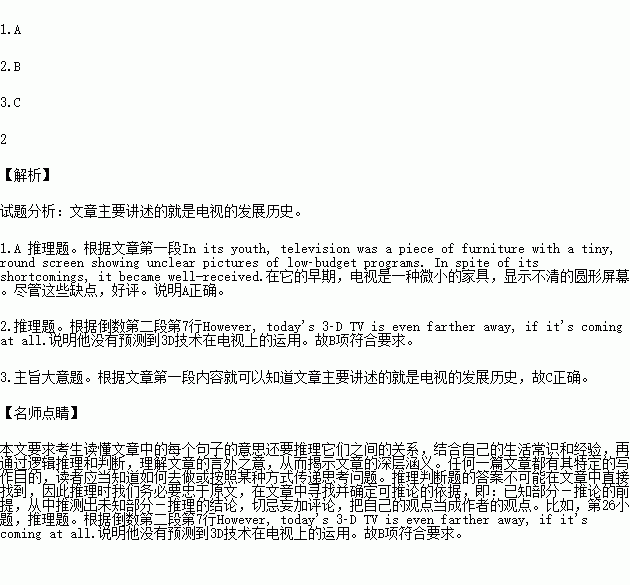题目内容
Television has turned 88 years old on September 7, 2015, and it has never looked better.
In its youth, television was a piece of furniture with a tiny, round screen showing unclear pictures of low budget programs. In spite of its shortcomings, it became well-received. Between 1950 and 1963, the number of American families with a television jumped from 9% to 92% of the population.
As the audience got larger, the technology got better. Television sets became more reliable through the 1960s. Both of the reception and the picture improved. The major networks started broadcasting programs in color.
Even greater improvements were coming according to Sanford Brown, who wrote an article for the Post in 1967. Surprisingly, just about every prediction he made in the article became a reality. For example: All sets in the not distant future will be color instruments. He also predicted that TV sets would become smaller, simpler, more reliable and less expensive and may forever put the TV repairman out of work. Smaller sets do not, of course, mean smaller screens. TV engineers expect screens to get much bigger. However, today's 3D TV is even farther away, if it's coming at all. There is some doubt whether the public would be eager to pay for it, in view of people's cold reception given to 3D movies.
But the technology with the greatest potential, according to Brown, was cable television (有线电视), which was still in its early stages then. As he predicted, the future of cable television was highly interactive. It wasn't cable television that gave Americans their electronic connection to the world, however. It was the Internet. He even foresaw the future office: using picture phones, big screen televisions for conferences, and computers providing information, at the touch of a button.
Brown ever said, “The future of television is no longer a question of what we can invent. It's a question of what we want.”
1.What can we infer about television sets in the 1960s?
A.They were very popular with Americans.
B.The reception showed no improvement
C.They showed black-and-white pictures
D.They were out of order now and then
2.Which of the followings did Sanford Brown fail to predict?
A.Television's good quality.
B.The invention of 3-D TV.
C.The future office’s model
D.The potential of cable TV.
3.What is the text mainly about?
A.The shortcomings of television.
B.The bright future of television.
C.The development of television.
D.The invention of television.
 名校课堂系列答案
名校课堂系列答案
